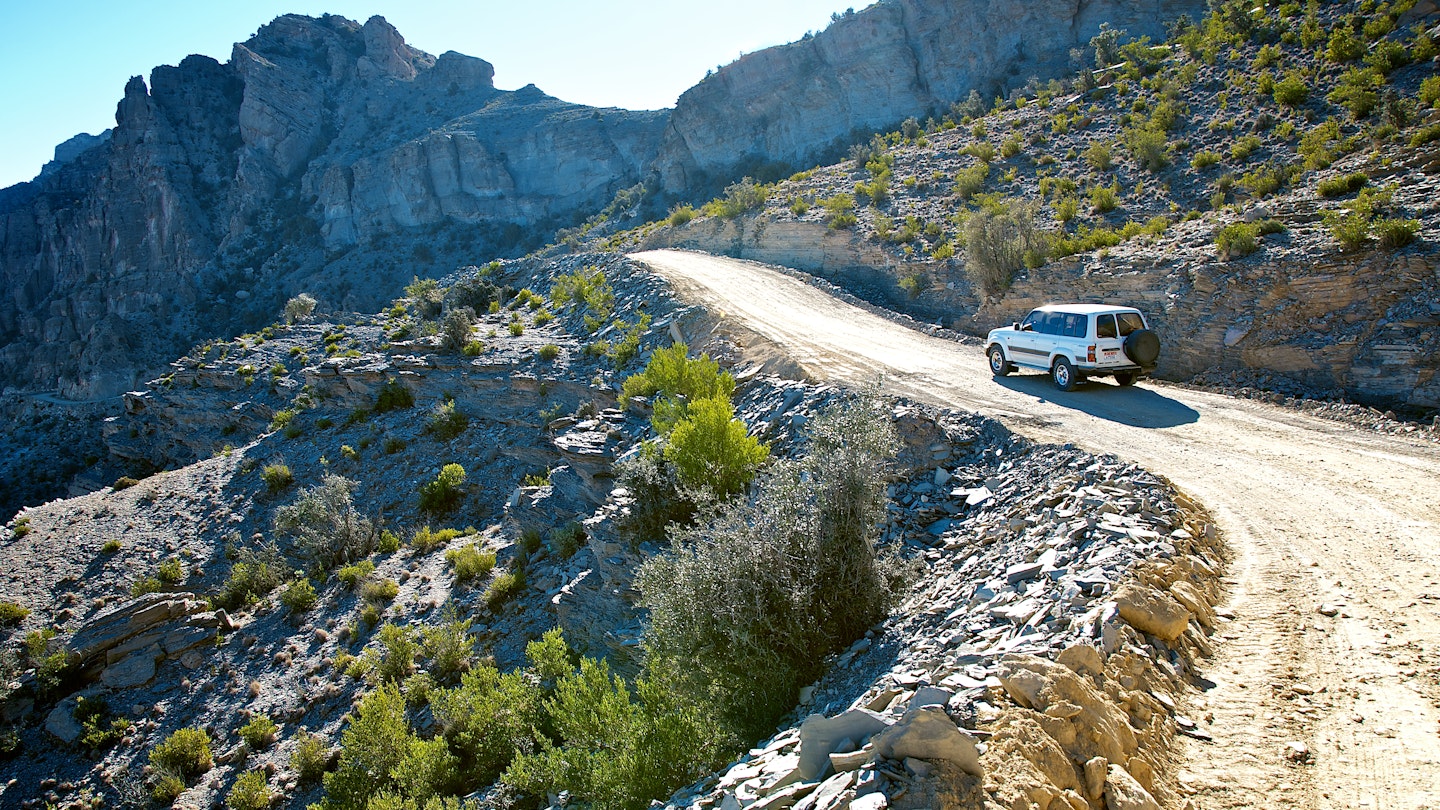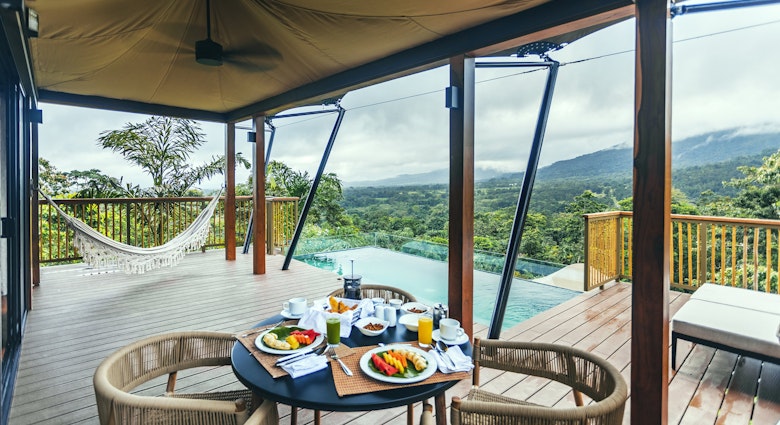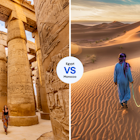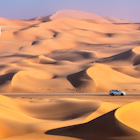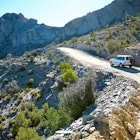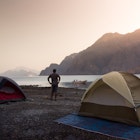Oman’s stunning landscapes are this country’s marquee attractions.
And to truly appreciate the rose-gold desert dunes, trails crisscrossing mountainous terrain, white-sand beaches, quiet fishing villages and rocky valleys with turquoise pools, it’s best to explore by car.
While Oman’s public transportation system of buses and ferries will get you between the main cities and towns, a private ride is recommended if you want to travel deeper in search of nature experiences such as hiking, diving or snorkeling – likely to be the highlights of any trip here.
In addition to accessing to remote areas around the country, getting around in Oman by car gives you flexibility in your travel plans. There’s nothing like chancing upon an empty beach tucked away in a cove and spontaneously deciding to set your tent up under a starry night sky.
If you plan a road trip across Oman’s different regions – from the desert landscapes of Al Buraimi in the northwest and coastal cities such as Muscat and Sur to fortified towns like Nizwa and Bahla in the interior and agricultural villages in the Hajar Mountains – you’ll need at least a week. Add another week to your itinerary if you’re keen to drive to the beaches, verdant wadis (valleys) and nature reserves of the Dhofar region in the south, perhaps visiting a few islands along the way.
Here’s how to get around Oman during your visit.
Cut down travel time in Oman by plane
Domestic flights are the best way to significantly reduce travel times between certain regions and avoid entire days of driving between them. Oman Air operates flights between Muscat, Duqm, Salalah and Khasab, and Oman-based low-cost airline Salam Air offers connections between Muscat, Sohar and Salalah. Tickets can be booked online.

A car is the easiest, most flexible way to see Oman
Renting a car is undoubtedly the easiest way to travel around Oman, giving you plenty of flexibility, the best value for money and the ability to reach remote locations you wouldn’t by other means. You’ll also have the freedom to wild-camp on public land: just bring a tent, food and sleeping bag.
Cars can be rented from international chains like Avis and Thrifty or local companies at a slightly lower rate, using your International Driving License. You can book your rental car in advance and pick it up at your arrival airport.
An extensive network of paved roads in good condition connects the main cities and regions. In Oman, vehicles are driven on the right-hand side of the road; most of the time, lane discipline is maintained, and traffic rules are respected. While driving in Muscat isn’t as nerve-wracking as in Dubai in the neighboring United Arab Emirates, if you find yourself being tailgated it’s best to move to the next lane and let the car pass.
Road signs are written in both English and Arabic. Speed limits are 120km/h (75mph) on highways, 90km/h (55mph) on rural roads and 40km/h (25mph) in residential areas; all roads are monitored through radars and speed cameras. Although you can navigate using Google Maps, the Waze app is more accurate. There are plenty of gas stations with stores and toilets along the main routes.
Between November and March, there can be days of heavy rainfall around the country, accompanied by thunderstorms and strong winds. On such days, road conditions are not ideal for driving: in Muscat, for example, roads can get waterlogged and some areas can get flooded, leading to traffic congestion. Since seas can be rough during such times, it’s best not to camp along the coast.
When planning a road trip around Oman, keep an eye on the weather and check the official website of the Directorate General of Meteorology for any warnings concerning flash floods, sandstorms and tropical cyclones.
If you plan on driving around in desert terrain or mountainous regions like Jebel Akhdar (where you can expect steep graded and dirt roads between villages and wadis), it’s sensible to rent a 4WD vehicle suitable for off-roading. Do not wander off existing tracks.
Off-roading requires skill, common sense and a good presence of mind. It’s wise to carry a long tow rope, traction mat and shovel, should your vehicle get bogged down somewhere. Ensure you always have enough water and some food in your car.
In Oman, it’s not uncommon to see 2WD cars ill-equipped for the rugged terrain of the mountains and desert dunes break down or get stuck in the sand. Generally, Omanis are helpful; should you find yourself in such a sticky situation, someone passing by will almost always stop to help. In remote areas, however, you might not have such luck.
When driving outside of the cities, keep an eye out for wandering camels and mountain goats. Flash floods can occur in the wadis just after it has rained, and it can be tricky to get out of overflowing wadis. Check the weather forecast and warnings before you set out.
Beware of driving on sabkha, a salt flat that seems like it’s solid and therefore easy to drive on only until you get stuck; this is not recommended for inexperienced drivers. Pay attention to signs warning visitors and avoid venturing farther.

Hailing a taxi in Oman
You’ll find privately owned orange-and-white taxis in Muscat and other cities outside shopping malls, hotels and tourist attractions: these are safe, well-maintained and comfortable. They’re also unmetered, so fares must be negotiated before you get in, but will almost always be cheaper than the alternative. The relatively newer, metered, government-operated Mwasalat taxis (in a red-and-white livery) are another option.
In Muscat, English is spoken, and drivers will be familiar with popular landmarks and tourist sights; otherwise, show them the location on a map on your smartphone. It’s also possible to hire a private taxi to travel between cities or for an entire day – ask the driver about fare and availability.
While Uber, Careem and Lyft are not available in Oman, local smartphone apps include Oman Taxi: Otaxi and Marhaba Oman taxi (the latter is slightly pricier). Both let you select your pick-up and drop-off locations on a map, connect you to the nearest driver and indicate approximate fares.
As per the unspoken rules of culture, women traveling alone are advised to sit in the rear seat directly behind rather than across from the driver’s side.
Budget travelers should consider the bus
The government-owned Mwasalat operates public buses within Muscat and Salalah as well as a network of intercity and inter-regional buses and ferries across Oman, including connections between Muscat and Nizwa, Duqm, Bahla, Sur, Buraimi, Masirah Island, Salalah and Khasab.
Visitors can consult daily schedules, routes and tariffs on the network’s website. Tickets are affordable – fares range from OR2 (US$5.20) to OR26 (US$67.50) – and can be bought on board. The Mwasalat smartphone app is useful for its journey planner and interactive map.
The buses are clean, comfortable, safe and air-conditioned. For travelers on a budget, buses offer the cheapest mode of transportation, both within cities and between them.

Explore the coastal islands by boat
Ferry services from the mainland make it possible to visit Oman’s coastal islands, where you’ll find dive sites thriving with marine life, nature reserves and pristine beaches. Mwasalat operates a ferry service between Masirah Island and Shannah Port on the southeastern coast, and also runs a bus from Muscat to Shannah Port. The journey to Hilf, the main town on Masirah Island, takes an hour. Cars can be transported on the ferry.
A ferry service also connects Shinas in northern Oman (reachable via bus from Muscat) to the ports of Khasab, Dibba and Lima on the Musandam Peninsula. You can check ferry routes, schedules, and tariffs and book tickets on the official National Ferries Company (NFC) website.
Water taxis are the most convenient way to travel between the marinas at Al Mouj and Bandar Al Rowdha in Muscat and Jebel Sifah Marina on the east coast.
The most straightforward way to reach the Daymaniyat Islands is with local operators like SeaOman, which organizes catamaran and powerboat trips to the islands, as well as diving, snorkeling and other water sports from Al Mouj Marina in Muscat and other locations along the coast. They’ll also arrange all the permits needed to visit these islands.
If you find yourself in a coastal town and want to explore nearby villages or islands (such as those close to Al Sawadi), it’s possible to rent one of the private boats from local operators and fishermen, either for the day or to be dropped off and then picked up at a specific time.
Accessible transportation in Oman
Most Mwasalat buses are wheelchair accessible, with low floors and extendable ramps. The NFC ferries to Masirah Island and Musandam are also wheelchair accessible. For road travel, it is more convenient to rent an accessible vehicle with a hired driver from a private operator than from a rental company.
In Muscat and other cities, newer and international hotels, shopping malls, tourist sights, marinas, some beaches and retail districts are accessible. In some locations, there are designated parking spaces reserved for people with disabilities.
You’ll find more information and tips on our accessible travel resource page.
You might also like:
10 must-see natural wonders in Oman
The 8 best places to visit in Oman: rugged mountains, seaside towns and culture-rich cities
The best times to visit Oman for blooming roses, racing camels and nesting sea turtles

